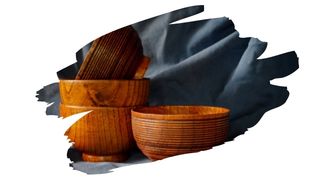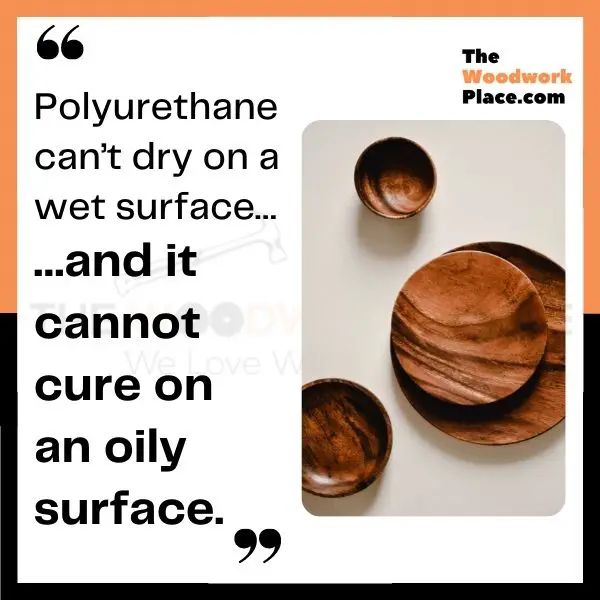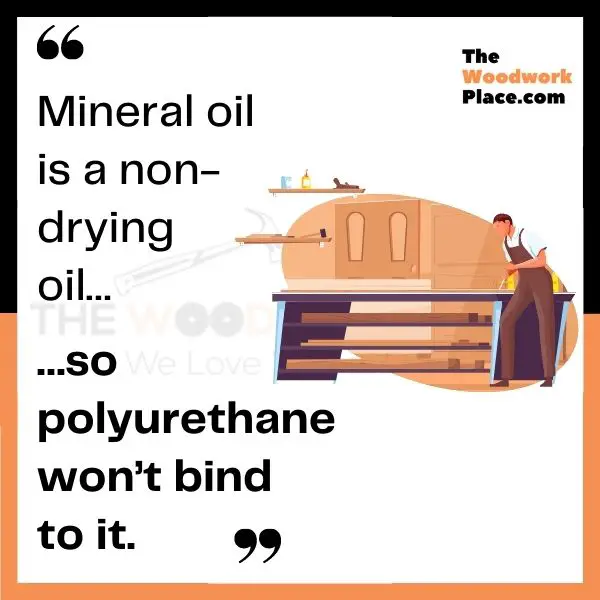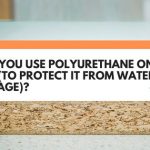A quality wood finish is key to preserving wood. It will stop water from soaking into wood grain, and prevent timber from succumbing to rot and decay.
But, while mineral oil is a popular food-safe wood finish, this non-drying oil isn’t durable. And, other than coating wood in water-repelling oil, it offers no other protection.
If you want a water-resistant and long-lasting finish, then polyurethane stands heads and shoulders above mineral oil. Still, can you apply polyurethane over a mineral oil coated wood craft?
In short, polyurethane can only be applied onto an oil finish that has dried and cured. However, mineral oil is a non-drying oil, so it will never dry-out or cure. Which is why polyurethane will not bind to a mineral oil finish.
But, is that all there is to it? Is there really nothing else to be done?
Well, in this post, you will learn exactly why polyurethane struggles to bind directly onto oily wooden surfaces. You will also discover what type of wood finish will stick to mineral oil.
Plus we reveal how you can use this finish to get polyurethane to adhere to that mineral oil coated lumber.

This post may contain affiliate links to products that we receive a commission for (at no additional cost to you). Learn more here.
Does Mineral Oil Alone Make Wood Waterproof?
Wood that has been thoroughly saturated with mineral oil will make wood a lot less water absorbent.
This food-safe finish will coat every wood fiber with a water-repelling grease. And this oily grease will be tough to wash off or remove afterwards.
Related Post: Don’t Put Tung Oil Over Mineral Oil (Here’s What You Should Do Instead)
But, mineral oil acts more like a wood preservative. It is not a durable sealer like epoxy resin or lacquer.
Which is why it can be tempting to want to seal over a mineral oil saturated wooden surface with a more water resistant finish… such as polyurethane.
But Polyurethane Won’t Stick And Stay On Oiled Wood, Right?
Polyurethane is a finish that will dry and cure onto the surface of wood. Yet, it cannot dry and cure onto a surface that is contaminated with dirt, grease or oil.
Now, just to be clear, polyurethane can be coated onto an oil finish. For example, polyurethane will stick and stay atop a Linseed oil or a Danish oil finish.
However, those finishes are drying oil finishes. Which means that they too, (just like polyurethane), will dry, cure, and eventually harden into a solid coat.
And provided that those drying oil finishes have cured, polyurethane can be applied over them.

The Big Problem? Mineral Oil Never Dries!
Mineral oil is a penetrating oil finish, just like a lot of wood oil finishes. But, it is one of a few oil finishes classed as a non-drying oil.
That means mineral oil won’t evaporate, or go through polymerization (the chemical process behind curing). And that means that once mineral oil has soaked into a wooden surface, polyurethane doesn’t stand a chance at adhering to that same surface.
If you can remove as much of that mineral oil from the surface of wood as possible, then a polyurethane top coat will stick… for a time.
But any mineral oil left inside wood grain can still seep back up. And once it does, that oil will weaken polyurethanes adhesion to wood.
So, What Kind Of Finish Can You Put Over Mineral Oil?
You can put mineral oil over mineral oil (just like you would when maintaining a cutting board). But, top coating sealers like polyurethane and lacquer aren’t going to stay on it.
Related Post: What Is The Difference Between Lacquer and Polyurethane?
However, there is one type of finish that will stick to a mineral oiled wooden surface… and that is dewaxed shellac.

Using Dewaxed Shellac As A Primer For Polyurethane Top Coat
Dewaxed shellac is some very sticky stuff. It will stick to just about anything… even an oily surface.
As a finish, dewaxed shellac isn’t very durable or very water resistant. But, as a primer coat, it will stick to most any top coat sealant.
So, using dewaxed shellac as a pre-sealant, you can coat over a mineral oiled surface. And then you can apply the polyurethane coat onto the dewaxed shellac coat instead.
You should still try to remove as much of the mineral oil as possible, first, before applying shellac.
Dewaxed Vs Waxed Shellac (Use The Right Type Of Shellac)
Quick caveat to all of this is that you must make sure you use a dewaxed shellac.
Waxed shellac is the fully waxed version of shellac finishes, and it looks like a cloudier version of dewaxed shellac.
However, polyurethane will peel right off waxed shellac. So, don’t use this particular type of shellac finish as a primer.
Related Post: Can You Put A Durable Lacquer Finish Over Shellac?
To Wrap Up, Here Are The 3 Key Takeaways…
- 1). Polyurethane can’t dry on a wet surface, and it cannot cure on an oily surface.
- 2). Mineral oil is a non-drying oil, so polyurethane won’t bind to it.
- 3). Use dewaxed shellac, (like a primer coat), over mineral oil. And then apply polyurethane to the shellac.



